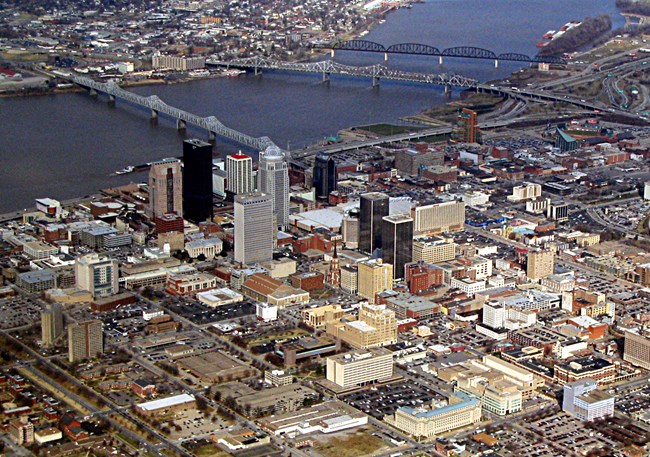Last updated: January 8, 2025
Article
Mulberry Hill

Ken Lund from Reno, Nevada, USA, CC BY-SA 2.0 <https://creativecommons.org/licenses/by-sa/2.0>, via Wikimedia Commons
Expedition members Captain William Clark and his enslaved man York lived at the Clark family homesite at Mulberry Hill, in Louisville, Kentucky, from 1785 to 1803. Not far from there, across the Ohio River, Clark and York met up with Captain Meriwether Lewis on October 14, 1803, to join the journey westward.9
Climate change has impacted Clark’s hometown. Average summer temperatures in Louisville have warmed 3.4 degrees since 1970. A 2014 study listed Louisville among the worst heat islands in the country, with temperatures 10 degrees warmer than surrounding areas. Heat-absorbing roofs, asphalt roads, and parking lots contribute significantly to this effect. About one-third of downtown Louisville is paved for parking. A 2016 urban heat management study, carried out by the city, suggested that reducing traditional pavement while increasing tree canopy and planted spaces, such as green roofs, could bring cooling benefits.10
Citations:
9 Kentucky Lewis and Clark Bicentennial Commission, “Lewis and Clark in Louisville, Kentucky,” 2024, https://lewisandclarkinkentucky.org/kentucky-places/mulberry-hill/; NPS, “Mulberry Hill” and “George Rogers Clark Homes Site at the Falls of the Ohio River,” Pittsburgh to the Pacific: High Potential Historic Sites of the Lewis and Clark National Historical Trail, 2022, 23–24, https://www.nps.gov/lecl/getinvolved/upload/2022_LCNHT_HPHS_Report_508compliantUPDATE-2.pdf.
10 Ryan Van Velzer, “Taking Stock: How Climate Change is Affecting Kentucky,” Louisville Public Media, June 21, 2023, https://www.lpm.org/news/2023-06-21/taking-stock-how-climate-change-is-affecting-kentucky; “Louisville’s Urban Heat Island,” June 15, 2024, https://www.wdrb.com/weather/wdrb-weather-blog/louisvilles-urban-heatisland/article_5aff19fc-2b19-11ef-856c-cbf7fff8a68d.html; Urban Climate Lab, George Institute of Technology, “Louisville Urban Heat Management Study,” April 2016, 61, https://louisvilleky.gov/sustainability/document/louisville-urban-heat-management-study-2016.
